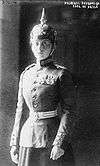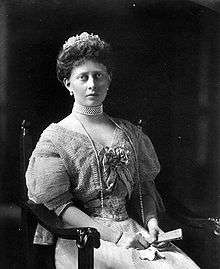Princess Margaret of Prussia
Princess Margaret of Prussia (Margarete Beatrice Feodora; 22 April 1872 – 22 January 1954) was a daughter of Frederick III, German Emperor and Victoria, Princess Royal and the younger sister of Kaiser Wilhelm II and a granddaughter of Queen Victoria. She married Prince Frederick Charles of Hesse, the elected King of Finland, making her the would-be Queen of Finland had he not decided to reject the throne. In 1926 they became Landgrave and Landgravine of Hesse. She lost three sons in both World Wars I and II.
Early life
Princess Margaret of Prussia was the youngest of eight children born to Frederick III, German Emperor, then heir of the German Empire and his wife, Victoria, Princess Royal, Queen Victoria's eldest daughter. Born on 22 April 1872 in the Hohenzollerns' New Palace in Potsdam, by the time the infant was christened, her head was covered with short hair like moss, from which she acquired her nickname "Mossy".[1] Her godparent was Emperor Pedro II of Brazil.[2] She was named Margarethe Beatrice Feodora, and Margaret, the Crown Princess of Italy, was her godmother.[1]
Princess Margaret grew up amid great privilege and formality.[3] Together with her sisters, Princess Viktoria and Princess Sophie, Margaret was deeply attached to her parents, forming an antagonist group to that of her eldest siblings, William II, Princess Charlotte and Prince Heinrich. She remained close to her mother after the death of her father. Margaret was widely regarded as the most popular of Kaiser Wilhelm II's sisters, and she maintained good relations with a wide array of family members.[3] She was a first cousin of both King George V of the United Kingdom and Empress Alexandra of Russia, all three being grandchildren of Victoria. As an adult, she was said to resemble her aunt, Princess Alice.[4]
Marriage

.jpg)
Princess Margaret was first attracted to Prince Maximilian of Baden.[5] When he did not reciprocate her affection, she moved on to her second choice, Max's close friend, Prince Frederick Charles of Hesse, future head of the Hesse-Kassel dynasty and future elected King of Finland.[5] They were married on 25 January 1893 at the Hohenzollern Stadtschloss in Berlin on the anniversary of her parents' wedding.[6]
At the time of the wedding, Prince Frederick Charles was not the Head of the House of Hesse-Kassel.[7] The position was held by his older and virtually blind brother Landgrave Alexander Friederich, who relinquished it in the mid-1920s in order to enter an unequal marriage.[7] Prince Frederick Charles, as was his title when he married, was addressed as His Highness, while Princess Margaret warranted Royal Highness. This disparity came to an end in 1925 when Frederick Charles became Landgrave of Hesse and Head of the house of Hesse-Kassel.[7]
They were second cousins, both great-grandchildren of King Friedrich Wilhelm III of Prussia, he through his mother Anna, she through her father Friedrich. Initially, her brother Wilhelm opposed the match as he felt that Frederick Charles's position was too "minor" for the Kaiser's sister. Later, however, he gave his blessing, since Margaret herself "was so unimportant".[8] The marriage was very happy. Princess Margaret had a strong personality; she would always seem more secure and grounded than her husband.[5] The couple's main residence during the early years of marriage was Schloss Rumpenheim. Margaret's husband was her mother's favorite son-in-law.[8] In 1901, Princess Margaret inherited Schloss Friedrichshof at the death of her mother.[3] It was highly unconventional for a husband to reside in his wife's home. However, Margaret was committed to maintain the house of her mother which entailed a great expense and the family moved to Friedrichshof.[3]
In 1918, Margaret's husband accepted the offer of the throne of newly independent Finland, but due to German misfortunes in World War I, soon renounced it. She would have become the Queen of Finland. Her predecessor as Grand Princess-consort of Finland was her first cousin, Empress Alexandra Feodorovna of Russia.
Children
Landgravine Margaret and her husband Frederick Charles of Hesse had six children, including two sets of twins:
- Prince Friedrich Wilhelm of Hesse-Kassel (24 November 1893– 12 September 1916), killed in action World War I.
- Prince Maximilian of Hesse-Kassel (20 October 1894 – 13 October 1914), killed in action World War I.
- Prince Philipp of Hesse-Kassel (6 Nov 1896 – 25 Oct 1980 Rome), married on 23 Sept 1925 to Princess Mafalda of Savoy (19 Nov 1902 Rome-28 Aug 1944), had issue.
- Prince Wolfgang of Hesse-Kassel (6 Nov 1896 – 12 Jul 1989), married Princess Marie Alexandra of Baden, no issue.
- Prince Richard Wilhelm Leopold of Hesse-Kassel (14 May 1901 – 11 Feb 1969).
- Prince Christoph of Hesse-Kassel (14 May 1901 – 7 Oct 1943), married Princess Sophie of Greece and Denmark (26 June 1914 Mon Repos, Corfu-24 Nov 2001 Bavaria) on 13 Dec 1930 (civil) and 15 Dec 1930 (religious), had issue. Killed in action World War II.
Family tragedies
Margaret's elder sons, Friedrich Wilhelm and Maximilian, were killed in action during World War I. Prince Maximilian, Princess Margaret's second and favorite son, was serving near Aisne when he was seriously wounded by machine gun fire in October 1914.[9] He died soon afterward and his body was secretly buried in the village of Caestre by the local people, who learned he was the Kaiser's nephew. The priest refused to identify the grave until the Germans had left Belgium and a compensation was paid. Max's younger brother Wolfgang appealed for help to the British authorities, and eventually, after an enquiry was made, Maximilian's body was returned to his family. Princess Margaret's oldest son, Friedrich Wilhelm died on 12 September 1916 at Kara Orman in Romania. He was killed in close fighting; his throat was slit by an enemy bayonet.[10]
Two other sons, Philipp and Christoph, embraced Nazism, hoping that Hitler would one day restore the German monarchy. Philipp married Princess Mafalda, daughter of King Victor Emmanuel III of Italy.[11] Due to his close relations with the King of Italy, Philipp was appointed in 1939 to Hitler's personal staff, since he could be a useful channel of communications between Nazi Germany and Fascist Italy. When he realised the reality of Nazism, he tried to resign, but he was not able to do so. He used his position and his money to provide passports for Jews and help them to escape to the Netherlands. Publicly, he continued with his duties and occasionally he made private missions in Italy for Hitler. When Italy capitulated, he personally informed Hitler. Hitler's revenge recoiled on Philipp, who was imprisoned in a concentration camp for political prisoners. Mafalda was taken to Buchenwald, where she died of a haemorrhage caused by the amputation of her arm, which had been mangled in a bombing raid on the camp.[12]
Landgravine Margaret's fifth son, Christoph, was a staunch supporter of the German war effort, but after the Battle of Stalingrad, he became frustrated by the limitations placed on his own role in the conflict, and increasingly critical of the German leadership.[13] Christoph's reaction to the assassination of Heydrich, whom he called a "dangerous and cruel man",[14] in 1942 was that it was "the best news I had in a long time".[14] The Nazi regime turned against his family and he was planning to leave the Nazi party when, on 7 October 1943, he died in a plane crash near Forli.[14][15] He was married to Princess Sophie of Greece, a sister of Prince Philip, Queen Elizabeth II's husband.
Landgravine Margaret also lost another one of her daughters-in-law during the war. Wolfgang's wife, Princess Marie Alexandra, when she and seven other women who were aid workers were killed in a bomb attack on Frankfurt on 29–30 January 1944.[16] The cellar in which they had taken refuge collapsed under the weight of the building, rendering Marie Alexandra's body barely recognisable.[17]
Landgravine Margaret, very much the matriarch, was at the centre of her large and dynamic family.[5] During and after World War II, she took care of many of her grandchildren and tried to preserve a centre at Friedrichshof as their parents faced various tribulations.[5]
Last years
Landgravine Margaret had difficult years after 1945; they were compounded by the theft from Schloss Friedrichshof in November 1945 of the family jewellery, valued at over £2,000,000.[18] After World War II, Friedrichshof was used as an officer's club by the military authorities during the American occupation. Princess Margaret's son Wolfgang, fearing for the jewels, had buried them in a subcellar of the castle.[18] On 5 November 1945, the manager of the club, Captain Kathleen Nash, discovered the jewels and together with her future husband, Colonel Jack Durant, and Major David Watson, stole the treasure and took the jewels out of Germany.[19] In early 1946, Princess Margaret discovered the theft when the family wanted to use the jewels for the wedding of Princess Sophia who was preparing to remarry. Princess Sophia and Landgravine Margaret denounced it to the Frankfurt authorities; the culprits were imprisoned but not until August 1951; the Hesse family received what had been recovered, only 10 percent of what had been stolen.[20]
Landgravine Margaret, the last surviving child of Emperor Frederick III, died in Kronberg on 22 January 1954,[21] 14 years after her husband and exactly 53 years to the day after her British grandmother Queen Victoria. She was 81 years old.
Titles, styles, honours and arms
Titles and styles
- 22 April 1872 – 25 January 1893: Her Royal Highness Princess Margaret of Prussia
- 25 January 1893 – 15 March 1925: Her Royal Highness The Hereditary Princess of Hesse, Princess of Prussia
- 9 October 1918 – 14 December 1918: Her Majesty The Queen of Finland and Karelia, Duchess of Åland, Grand Duchess of Lapland, Lady of Kaleva and the North
- 15 March 1925 – 28 May 1940: Her Royal Highness The Landgravine of Hesse
- 28 May 1940 – 22 January 1954: Her Royal Highness The Dowager Landgravine of Hesse
Honours
Ancestry
Gallery
| Wikimedia Commons has media related to Princess Margaret of Prussia. |
 Princess Margaret
Princess Margaret Princess Margaret and her husband
Princess Margaret and her husband Princess Margaret in uniform
Princess Margaret in uniform
Notes
- 1 2 Pakula, An Uncommon Woman , p. 298
- ↑ Longo, James McMurtry. Isabel Orleans-Bragança: the Brazilian princess who freed the slaves. Jefferson: McFarland & Company, 2008, p.192
- 1 2 3 4 Petropoulos,Royals and the Reich , p. 34
- ↑ Packard, Jerrold M. (1999). Victoria's Daughters. St Martin's Press. p. 295. ISBN 9780312244965.
- 1 2 3 4 5 Petropoulos,Royals and the Reich , p. 35
- ↑ Pakula, An Uncommon Woman , p. 557
- 1 2 3 Petropoulos,Royals and the Reich , p. 33
- 1 2 Packard, p. 295
- ↑ Petropoulos,Royals and the Reich , p. 43
- ↑ Petropoulos,Royals and the Reich , p.44
- ↑ Petropoulos,Royals and the Reich , p. 75
- ↑ Petropoulos,Royals and the Reich , p. 303
- ↑ Petropoulos ,Royals and the Reich , p. 307
- 1 2 3 Vickers, Hugo (2003). Alice: Princess Andrew of Greece. St. Martin's Griffin. p. 301. ISBN 9780312302399.
- ↑ Petropoulos,Royals and the Reich , p. 308
- ↑ Petropoulos,Royals and the Reich , p. 317
- ↑ Petropoulos,Royals and the Reich , p. 318
- 1 2 Petropoulos,Royals and the Reich , p. 344
- ↑ Petropoulos,Royals and the Reich , p. 345
- ↑ Petropoulos,Royals and the Reich , p. 349
- ↑ Pakula, An Uncommon Woman , p. 599
Bibliography
- Henri van Oene, Genealogy of the Royal Family of Prussia, 13 May 1998, 18 September 2011 <http://web.archive.org/web/20091028120246/http://www.geocities.com/henrivanoene/genprussia06a.html>.
- Pakula, Hannah, An Uncommon Woman, Simon & Schuster, New York, 1995, ISBN 0-684-84216-5
- Petropoulos, Jonathan, Royals and the Reich, Oxford University Press, New York, 2006, ISBN 0-19-516133-5
- Van der Kiste, John, The Prussian Princesses: Sisters of Kaiser Wilhelm II, Fonthill, 2014

